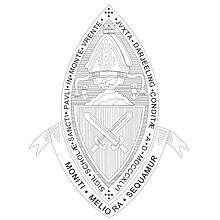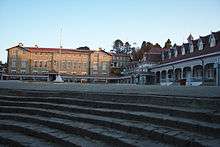St. Paul's School, Darjeeling
| St. Paul's School, Darjeeling | |
|---|---|
 | |
| Location | |
|
Darjeeling, West Bengal India | |
| Information | |
| Type | Independent school |
| Motto |
Moniti Meliora Sequamur Latin: Having been advised, let us follow higher things |
| Religious affiliation(s) | Church of North India |
| Established | 1823 |
| Rector | Joy Halder |
| Gender | Boys |
| Age | 6 to 18 |
| Enrollment | 800 |
| Houses | 12 |
| Colour(s) |
Maroon and dark blue |
| Publication |
The Chronicle The Paulite |
| Former pupils | Old Paulites |
| Website |
http://stpaulsdarjeeling.com/ http://spsdarj.org/ |

St. Paul's School is an independent boarding school for boys in the town of Darjeeling, West Bengal, India. Entrance tests for admission are held every September. The school follows the ICSE curriculum till the class 10 and the ISC for higher secondary (classes 11 and 12).
History
St. Paul's School was founded in Calcutta by Archdeacon Corrie[1] at the instigation of John William Ricketts, a local Anglo-Indian leader, and opened at 11 Park Street on 1 May 1823. The school was moved to its present Jalapahar estate in Darjeeling in 1864 with 31 boarders and a few day scholars. At that time, at approximately 7,600 feet above sea level, it was the highest school in the world.[2] A number of its students fought in World War I and World War II. The school's original purpose was "to supply a good education at a moderate cost to the sons of Europeans and East Indians". After Indian Independence in 1947 it became a school for wealthy Indians and attracted wealthy students from other Asian countries, as of 1960 especially from Burma, Thailand and Sri Lanka.[3][2]
Bishop Foss Westcott, metropolitan of Bengal, Burma and Ceylon, played an important role in the growth of the school. The Maharajah of Burdwan also made important donations.[2] Over the years a number of estates were purchased and merged with the existing school estate. The Mount Vernon Estate, known as Dawkins, was purchased at the beginning of the 1900s and the Terpsithea Estate in 1955.
School system
The school is divided into Primary, Junior, and Senior wings. The three wings are run independently with the Primary Wing having its own campus and a slight difference in uniform. The Senior and Junior Wings share many facilities.
The rector is the head of the school, assisted by the senior master, the head Junior Wing and the head Primary Wing.
Culture
Current students are referred to as Paulites and the alumni as Old Paulites. The school lays a great emphasis on uniforms: On off-campus trips students must dress in prescribed suits and carry umbrellas.
The student government is headed by a school captain, assisted by house captains and prefects, drawn from the Sixth Form. The Junior and Primary Wings have their own system of monitors. The Sixth form is privileged and enjoys an advantage over the rest. The chapel holds a central place in the life of the school where it meets as a community. There are clubs which develop artistic and technical skills. Each house presents a concert from time to time, apart from the major school production in October.
The sport curriculum is dominated by football, cricket, athletics and hockey.
Notable alumni
External links
| Wikimedia Commons has media related to St. Paul's School, Darjeeling. |
References
- ↑ Eyre Chatterton, A History of the Church of England in India Since the Early Days of the East India Company, London: SPCK / New York: Macmillan, 1924, OCLC 1895674, "Chapter XXVII. The Mother Diocese of Calcutta, 1815".
- 1 2 3 Educational Institute, City of Darjeeling, retrieved 24 September 2013.
- ↑ Gordon Brook-Shepherd, Where the Lion Trod, London: Macmillan / New York: St. Martin's, 1960, OCLC 411159, pp. 65–66. Text online at archive.org.